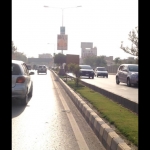Signs in Pakistan are typically used to provide information and guidance to the public. They are commonly seen on roads, buildings, and other public spaces. Signs in Pakistan can range from simple street signs to elaborate billboard advertisements.
Signs in Pakistan are used to denote the language, culture, and customs of the country. For instance, many signs are written in Urdu, the national language of Pakistan, while others may be in English or regional languages. Additionally, signs can showcase traditional artwork and symbols, such as the Pakistani flag, crescent moon, and star.
Signs in Pakistan also serve as warnings or reminders to the public. For example, signs are often used to indicate speed limits, no parking zones, and restricted areas. Furthermore, signs are used to mark public places, such as schools, hospitals, and government offices.
In conclusion, signs in Pakistan are an important part of the country’s culture and infrastructure. They provide guidance to the public, showcase traditional artwork and symbols, and serve as warnings and reminders.
Top 5 Signs Companies in Peshawar, Pakistan
List of top verified Signs Companies in Peshawar, Pakistan, near me. Last updated Dec 2024
We found 5 directory listings in Peshawar
Sky Vision Print & Design Company
Address: Off# 221 Nadeem Trade Centre, Jangi street, Qissa Khawani Bazar Peshawar, Pakistan, Khyber Pakhtunkhwa

Verified+9 Years with us
0912567722
2001 Established
E-mail
Map
Website
4 Photos
Millat Advertisers
Address: Office No. 214, Nadeem Trade Centre, Mohallah Jangi, Qissa Khwani, Peshawar, Khyber Pakhtunkhwa, Pakistan

Verified+7 Years with us
+92-316-9752774
2007 Established
E-mail
Map
Website
1 Photos
Adscanyon
Address: Fursan Business Lounge Opposite UET Mardan, Peshawar, Khyber Pakhtunkhwa, Pakistan

Verified+8 Years with us
03455597695
2016 Established
E-mail
Map
Website
1 Photos
Elite Business Advertiser
Address: Shekh Yaseen tread center 6th floor Office #604, Peshawar, Khyber Pakhtunkhwa, Pakistan

Verified+9 Years with us
03449060548
2007 Established
E-mail
3 Photos
Macroosm Advertisers
Address: Cantt., NWFP, Peshawar, Pakistan
9291-5287356 / 5286413
E-mail
Filter by City
- Karachi53
- Lahore46
- Faisalabad4
- Rawalpindi6
- Multan2
- Hyderabad0
- Gujranwala2
- Peshawar5
- Quetta2
- Islamabad8
Related Categories
- Advertising77
- 3D Displays4
- 3D Visualisations3
- Advertising Agencies16
- Advertising Equipment3
- Advertising Software3
- Brand Management6
- Cameramen1
- Cartoonists1
- Catalogue Designers1
- Copywriters1
- Corporate Identity Design0
- Design Agencies1
- Design Consultants3
- Digital Marketing1
- Digital Media6
- Digital Signage1
- Flat Screen Advertising0
- Graphic Design9
- Graphic Materials Supply0
- Illustrators1
- Leaflet Distribution0
- Logo Design0
- Magazine Publishing2
- Media Agencies2
- Media Consultancy0
- New Media1
- Newspaper Publishers13
- Online Advertising3
- Outdoor Advertising4
- Photography Services2
- Photography Studio0
- Radio Advertising0
- Signs5
- SMS Marketing4
- Social Media2
- T-Shirt Printing0
- Video Production3
- Virtual Tour Photography0